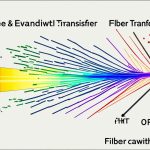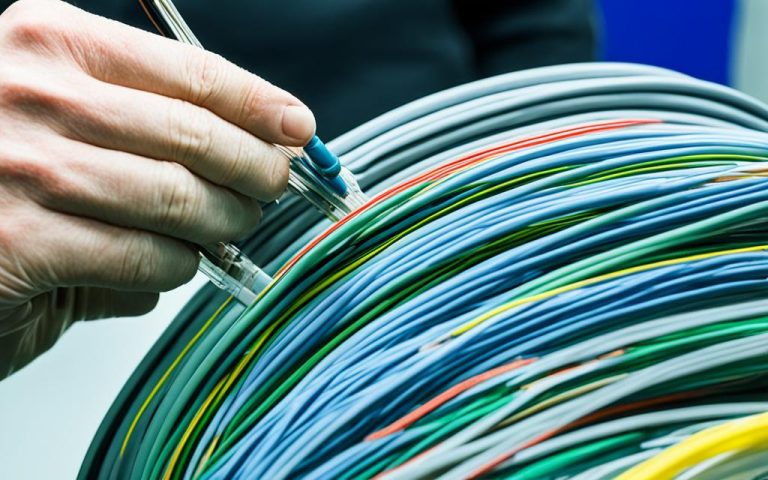Efficient and high-speed digital communication is a necessity in today’s rapidly advancing world. Fibre Optic Networks play a pivotal role in enabling this seamless connectivity. By utilizing pulses of light to transmit signals, fibre optic networks offer numerous advantages over traditional copper cables, including higher bandwidth and longer distance wired networks.
Understanding the types and usage of fibre optic networks is crucial for professionals in the communication industry. With different types of fibre optic cables available, such as single mode and multimode, each with its own characteristics and applications, it is essential to have a comprehensive understanding of their capabilities and how they can be effectively utilized in various scenarios.
From telecommunications to data centers, fibre optic networks have a wide range of applications in our digital-driven society. By harnessing the power of fibre optic networks, businesses and individuals can achieve faster and more reliable connectivity, paving the way for advancements in technology and communication.
In this article, we will delve deeper into the world of fibre optic networks, exploring how these networks work, the different types of fibre optic cables, their applications, and the advantages they offer. Stay tuned to gain a comprehensive understanding of the power and potential of fibre optic networks in the realm of digital communication.
How Fibre Optic Cables Work
Fibre optic cables play a crucial role in modern communication systems, enabling the transmission of signals at high speeds and over long distances. To understand how these cables work, it’s essential to explore their key components and mechanisms.
The Optical Core: Carrying Light Signals
At the heart of a fibre optic cable is the optical core, a glass tube where light signals are carried. This core is responsible for guiding the light pulses from one end of the cable to the other. The glass material used in the core is chosen for its high transparency to light and low signal loss.
Core Sizes and Signal Transmission
The size of the core in a fibre optic cable plays a significant role in determining the distance the signal can travel. Smaller cores allow for longer distances, while larger cores are suitable for shorter connections. For example, single mode fibres, with a core size of around 9 microns, can transmit signals over much greater distances compared to multimode fibres, which typically have a core size of 50 or 62.5 microns.
Wavelengths: Guiding Light Through the Core
Another critical aspect of fibre optic cable functionality is the use of different wavelengths of light. The choice of wavelength depends on whether the cable is single mode or multimode. Single mode fibres transmit light signals at a specific wavelength, typically around 1310 or 1550 nanometers, guiding the light through the core in a straight line. On the other hand, multimode fibres transport light signals at multiple wavelengths, allowing for shorter transmission distances due to the dispersion of light paths.
Understanding the interplay between core sizes and wavelengths is vital for designing and deploying fibre optic networks suitable for specific communication needs.
In the next section, we will explore the different types of fibre optic cables available in the market, each with its own characteristics and applications.
Types of Fibre Optic Cables
When it comes to fibre optic cables, there are different types available in the market to suit various applications and requirements. These cables can be broadly categorized into two main types: Multimode Fibre and Single Mode Fibre.
Multimode Fibre
Multimode fibres, identified by the OM (optical mode) designation, disperse light into multiple paths. These cables are commonly used for short-distance applications, making them ideal for environments like data centers. Multimode fibres come in several types, including:
- OM1: This type has a core size of 62.5 micrometers and can support data rates of up to 10 Gigabits per second (Gbps) over a distance of 33 meters.
- OM2: Featuring a core size of 50 micrometers, OM2 fibres can support data rates of up to 10 Gbps over a distance of 82 meters.
- OM3: With a core size of 50 micrometers, OM3 cables can support data rates of up to 10 Gbps over a distance of 300 meters.
- OM4: Similar to OM3, OM4 fibres also have a core size of 50 micrometers. However, they offer an extended reach of up to 550 meters at 10 Gbps.
- OM5: The latest addition to the multimode fibre family, OM5 cables have a core size of 50 micrometers, and they are designed to support wavelength division multiplexing (WDM) technology. This allows for the transmission of multiple signals with different wavelengths over a single fibre, enabling increased capacity and flexibility in short-range applications.
Single Mode Fibre
Single mode fibres, identified by the OS (optical single-mode) designation, have a smaller core diameter compared to multimode fibres. These cables are primarily used for long-distance transmission, offering low signal attenuation and enhanced performance. Single mode fibres are classified into two types:
- OS1: Single mode fibres in this category are optimized for indoor use and can support data rates of up to 10 Gbps over a distance of 2 kilometers.
- OS2: Designed for outdoor and longer distance use, OS2 fibres can support data rates of up to 100 Gbps over distances exceeding 10 kilometers.
Choosing the right fibre optic cable type depends on various factors such as the required data rates, distance, and environmental conditions. Understanding the differences between multimode and single mode fibres is crucial in determining the most suitable solution for your specific application.
In the exploration of fiber optic cables and their applications, a notable mention is the Gigabit Passive Optical Network (GPON). GPON is a highly efficient form of fiber optic network that offers increased bandwidth, enhanced security, and greater energy efficiency through its use of passive splitters. This technology enables the delivery of high-speed internet, voice, and video services from a single fiber optic line, extending to multiple endpoints. GPON’s architecture allows for a reduction in the amount of active equipment needed, thereby lowering costs and maintenance requirements while providing scalable solutions for future expansion. Its inclusion in the realm of fiber optic networks underscores the ongoing advancements in technology aimed at meeting the growing demands for faster and more reliable digital communication.
Applications and Advantages of Fibre Optic Networks
Fibre optic networks provide a multitude of applications across various industries, revolutionizing the way we communicate and access information. From telecommunications to data centers and smart cities, the advantages of fibre optic networks are undeniable.
Applications
- Telecommunications: Fibre optic networks are the backbone of modern telecommunication systems, enabling fast and reliable transmission of voice, data, and video signals over long distances.
- Data Centers: With increasing data demands, fibre optic networks play a crucial role in connecting data centers, facilitating seamless data transfer and storage.
- Smart Cities: Fibre optic networks form the infrastructure for smart city initiatives, supporting advanced technologies such as IoT devices, intelligent traffic systems, and remote monitoring systems.
Advantages
One of the key advantages of fibre optic networks lies in their unparalleled bandwidth capabilities. Compared to traditional copper wires, fibre optic cables can transmit large amounts of data at incredibly fast speeds, meeting the growing demands of our digital world.
Another significant advantage is the reduced latency experienced with fibre optic networks. With lower latency, there is minimal delay in data transmission, leading to improved performance and real-time interactive experiences.
“Fibre optic networks offer higher bandwidth and lower latency, resulting in faster data transmission and improved user experiences.”
Additionally, fibre optic networks are immune to electromagnetic interference, making them highly reliable and secure for transmitting sensitive information. This immunity also eliminates the need for frequent signal regeneration, allowing signals to be transmitted over longer distances without loss or degradation.
Furthermore, fibre optic cables have minimal signal attenuation, meaning that the signal does not significantly weaken as it travels along the cable. This allows for longer transmission distances without sacrificing signal quality.
Fibre optic networks are essential for supporting the increasing demand for high-speed connectivity in today’s digital landscape, powering our communication infrastructure and driving technological advancements.
The advantages of fibre optic networks are summarized in the table below:
| Advantages | Explanation |
|---|---|
| Higher Bandwidth | Fibre optic networks offer significantly higher bandwidth compared to traditional copper cables, allowing for the transmission of large volumes of data. |
| Lower Latency | The reduced latency of fibre optic networks ensures faster response times and real-time interactions. |
| Immunity to Electromagnetic Interference | Fibre optic cables are not affected by electromagnetic interference, ensuring secure and reliable data transmission. |
| Minimal Signal Attenuation | Fibre optic cables have minimal signal attenuation, enabling longer transmission distances without signal degradation. |
With these advantages, fibre optic networks continue to shape the connectivity landscape, enabling seamless and efficient communication across various industries.
Fiber Optic Protocols
Fiber optic networks, renowned for their high-speed digital communication capabilities, rely on a variety of fiber optic protocols to ensure efficient and reliable data transmission. These protocols govern how data is formatted, transmitted, and received over fiber optic cables, playing a crucial role in optimizing the performance and security of fiber networks.
Fiber optic networks, renowned for their high-speed digital communication capabilities, rely on a variety of fiber optic protocols to ensure efficient and reliable data transmission. Among these, the Optical Transport Network (OTN), also known as the digital wrapper, is pivotal. It consolidates the benefits of optical networking with digital transport systems, enabling efficient network management and monitoring.
- Transmission Protocols: Protocols like Synchronous Optical Networking (SONET) and Synchronous Digital Hierarchy (SDH) are fundamental in fiber optic communications, providing a framework for data transmission that ensures integrity and synchronization.
- Multiplexing Techniques: Dense Wavelength Division Multiplexing (DWDM) and Coarse Wavelength Division Multiplexing (CWDM) are key protocols that allow multiple data signals to be transmitted simultaneously on the same fiber optic cable by using different wavelengths (colors) of light. This significantly increases the capacity of fiber networks without laying more cables.
- Network Management Protocols: To effectively manage and monitor fiber optic networks, protocols such as Simple Network Management Protocol (SNMP) and Network Configuration Protocol (NETCONF) are utilized. These protocols help in diagnosing network issues, monitoring traffic, and configuring network devices remotely.
- Security Protocols: With the increasing reliance on fiber optic networks for critical data transmission, implementing robust security protocols is paramount. Protocols like IPsec and Secure Sockets Layer (SSL)/Transport Layer Security (TLS) provide encryption and authentication to safeguard data as it travels across the network.
- Emerging Protocols: As fiber optic technology evolves, new protocols are being developed to address the growing demands for speed and efficiency. Protocols focusing on higher bandwidth utilization, reduced latency, and enhanced security features are in continuous development to support future network needs.
Understanding these protocols is essential for professionals in the communication industry to design, deploy, and maintain efficient and secure fiber optic networks. By staying informed about protocol advancements, businesses and individuals can leverage the full potential of fiber optic technology, ensuring high-speed connectivity that meets the digital demands of today and tomorrow.
Conclusion
Fibre optic networks are paramount in facilitating efficient and high-speed network digital communication. By utilizing pulses of light to transmit signals, fibre optic networks offer significant advantages over traditional copper cables. Professionals in the communication industry must comprehend the various types and applications of fibre optic cables to leverage their benefits.
Whether it is single mode or multimode fibres, each type possesses distinct characteristics and utility. Embracing the capabilities of fibre optic networks empowers businesses and individuals to attain faster and more reliable connectivity, thus paving the way for advancements in technology and communication.
With their ability to transmit signals using pulses of light, fibre optic networks revolutionize the way we connect and communicate. As we continue to rely on high-speed communication, the benefits of fibre optic networks become increasingly apparent. They play an integral role in driving the future of digital connectivity, ensuring efficient data transmission, and meeting the ever-growing demand for seamless communication experiences.
FAQ
What are the advantages of fibre optic networks compared to traditional copper cables?
Fibre optic networks offer higher bandwidth, lower latency, immunity to electromagnetic interference, minimal signal attenuation, and the ability to transmit signals over longer distances without regeneration.
What is the difference between single mode and multimode fibre optic cables?
Single mode fibres have a smaller core diameter and are used for long-distance transmission, while multimode fibres disperse light into multiple paths and are ideal for short-distance applications.
What types of multimode fibres are available in the market?
Multimode fibres are available in various types such as OM1, OM2, OM3, OM4, and the latest OM5. Each type has different core sizes, data rates, and distances it can support.
What are the classifications for single mode fibres?
Single mode fibres are classified as OS1 and OS2, with OS2 being more suitable for outdoor and longer distance use.
What are the applications of fibre optic networks?
Fibre optic networks have a wide range of applications, including telecommunications, data centers, smart cities, and more.




















One Comment